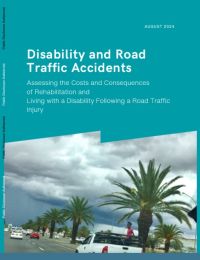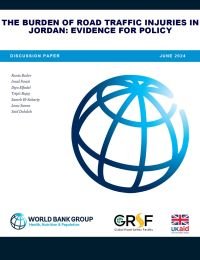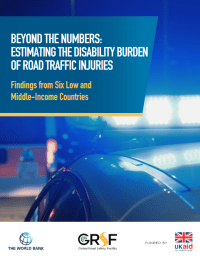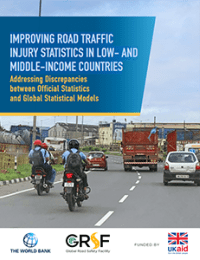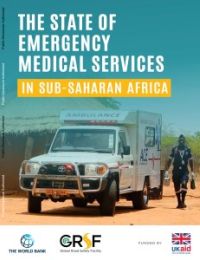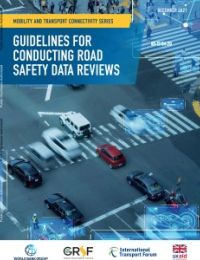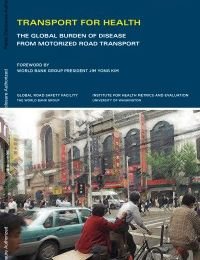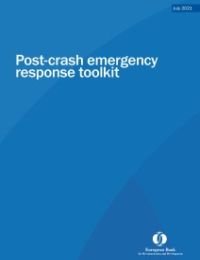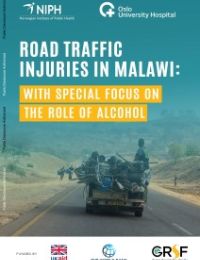Publications
1-10 of 13
-
-
-
Post-Crash Health Care
Beyond the Numbers: Estimating the Disability Burden of Road Traffic Injuries
November 2023
-
Road Safety Data
Improving Road Traffic Injury Statistics in Low- and Middle-Income Countries
November 2023
- National decision-makers recognize the issue of underreporting but tend to dismiss higher estimates by global statistical models.
- Most countries use WHO GSRRS estimates.
- National health surveys and censuses in LMICs often contain relevant information, and minor modifications can greatly improve their usage for such measurements.
- Incorporating national health survey data into global statistical models can help resolve discrepancies and increase confidence in estimates.
- Integrating epidemiological data sources into global statistical models (GBD, GHE, GSRRS) to reduce discrepancies and increase confidence in their estimates.
- Including relevant questions in upcoming national data collections to facilitate epidemiological measurements of road traffic injuries.
- Encouraging local involvement in data production for better estimates.
- Enhancing coordination between the Institute for Health Metrics and Evaluation and the World Health Organization to improve estimates and reduce inconsistencies.
-
-
-
Post-Crash Health Care
Transport for Health: The Global Burden of Disease from Motorized Road Transport
August 2021
-
- reasons for taking action
- the main elements of post-crash response
- examples of best practice
- helpful resources.
- government departments and policymakers
- local and regional government
- emergency service managers and professionals
- paramedics and community responders
- laypeople and members of the community
- crash survivors, families, and organizations representing them.
-
-
Post-Crash Health Care
Road Traffic Injuries in Malawi: With Special Focus on the Role of Alcohol
June 2021
-
Of 1347 eligible patients who were asked to participate during a period of about three months, 1259 (93.5 percent) gave informed consent, eight patients were not tested for alcohol and thus excluded, resulting in 1251 patients in the study.
-
The prevalence of alcohol was 30.7 percent among males and only 2.5 percent among females, who represented 19.2% of the total cases. There were minor differences across different age groups, with the highest prevalence of alcohol use among those between 25 and 44 years of age (26-27 percent) and lowest among those 45 years of age and older (19.7 percent).
-
The highest prevalence of alcohol was found among patients with no formal education (33.3 percent) compared to patients with college or university education (22.1 percent) with the lowest prevalence.
-
When comparing the different road users, the highest prevalence of alcohol was found among pedestrians (41.8 percent) while the prevalence among the other road users varied from 19.1 percent (bicycle riders) to 24 percent (motorcycle riders).
-
Patients injured during weekend night crashes, showed the highest prevalence of alcohol (59.6 percent), followed by those injured during weekend evenings (36.8 percent) and weekday nights (35.3 percent).
-
Regarding drinking habits, measured by the AUDIT-C questionnaire, hazardous drinking was more common among males (26 percent) than among females (4.2 percent). Age group 25-34 years had the highest prevalence of positive AUDIT-C test (26 percent).
-
The blood alcohol concentrations (BACs) at the time of injury were estimated by back-calculation for road users who were tested for alcohol within five hours after injury in accordance with forensic medicine practices. An estimated proportion of 15.2% of the injured motor vehicle drivers had BAC at or above 0.08g/dl when the crash occurred.
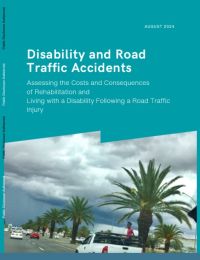
This GRSF-funded study explores the medical, economic, and social costs of road traffic accidents (RTAs), particularly focusing on individuals with permanent disabilities. According to the World Health Organization (WHO), RTAs are a global public health crisis, ranked as the 12th leading cause of death and the primary cause of mortality among children and young adults. While the UN's Decade of Action for Road Safety (2021–2030) aims to reduce RTA deaths, the study argues that more focus is needed on injuries and the long-term impact on those left disabled by RTAs.
Building on GRSF’s report Beyond The Numbers: Estimating the Disability Burden of Road Traffic Injuries (Mitra et al., 2023), this project examines data from Namibia and South Africa and interviews with experts to highlight the often-overlooked challenges faced by RTA-related disability survivors. These individuals encounter unique issues—such as brain injuries, psychological trauma, and sudden financial burdens—that require specific support mechanisms beyond general disability frameworks.
Economic losses from RTAs are substantial, with WHO estimating global costs up to $1.8 trillion annually. However, existing research focuses mainly on medical costs and productivity losses, neglecting broader social impacts. Data on the prevalence of permanent disabilities varies, underscoring the need for standardized research.
The study calls for integrating disability concerns into road safety policies, emphasizing that improved enforcement in low- and middle-income countries could prevent disabilities and reduce societal costs. Ultimately, it advocates for recognizing RTA-related disabilities as a critical issue within global health, disability policy, and development agendas.
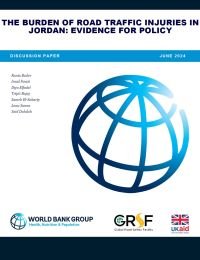
Road traffic injuries (RTIs) are a critical public health issue in Jordan, as highlighted in the 2022 Annual Report of Traffic Accidents from the Jordan Public Security Directorate. With 169,409 crashes recorded in 2022, resulting in 562 deaths and 11,510 injuries, RTIs have emerged as the leading cause of death for children and young people, and the second-leading cause for adults aged 20–64.
This analytical research study aims to understand RTI-induced disabilities in Jordan, identify contributing factors, and assess the associated costs for road traffic crash victims. Using a mixed-methods approach, the research included quantitative and qualitative data collection through hospital-based surveillance and follow-up surveys at one- and three months post-injury. The study involved six public and private hospitals across Jordan. Key informant interviews with stakeholders from various sectors were conducted to gain comprehensive insights.
The study's findings reveal that most RTI patients were male (79%) with an average age of 34 years. Crashes predominantly occurred during early mornings and night hours, involving mainly cars (72%) and motorcycles/bicycles (40%). A significant number of patients (74%) received prehospital care, primarily from ambulance staff. Most patients (66%) were fully conscious upon arrival at the emergency room.
Injury analysis showed that 58% of patients had a single injury, with extremities being the most affected area. Financially, 49% of patients incurred immediate costs upon hospital admission, and follow-up care also resulted in out-of-pocket expenses, particularly for physiotherapy and medications.
The study indicated that 79% of patients experienced some disability at the one-month follow-up, with varying degrees from mild to extreme. By the third month, 73% reported no disability, though 26% continued to experience mild impairments.
This study underscores the significant burden of RTIs and associated disabilities in Jordan, highlighting the need for targeted interventions to reduce injuries and robust long-term care to support affected individuals.
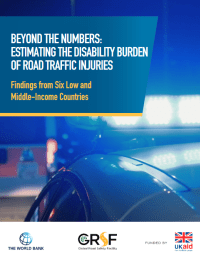
It is well-documented that road crashes claim around 1.35 million lives each year and rank as the eighth leading cause of death globally, causing huge burdens for economies, health systems, and transport networks. However, beneath the sobering fatality statistics lies a largely unexplored landscape: the staggering toll of disabilities induced by road crashes. Until now, the focus of road safety research and policy discourse has predominantly revolved around fatalities, which has limited our understanding of traffic-related injuries and disability burdens at the individual, community, and national level.
To address this critical knowledge gap, this pioneering study—involving over 2,300 patients hospitalized for road crash injuries—provides valuable insights into the prevalence, causes, and long-term impacts of crash-related disabilities. By broadening the discussion beyond fatalities to the often-overlooked issue of disability, the report paves the way for a more holistic perspective on road safety impacts, which can inform more effective road safety policies.
This report is a call to action for comprehensive and context-specific interventions that encompass both the transport and health sectors. Effective measures may include implementing safety regulations, enhancing emergency services, strengthening rehabilitative care, and expanding social safety nets to ease the financial burden on crash survivors. Collaborative efforts between governments, global and regional organizations, civil society, and other stakeholders will be indispensable.
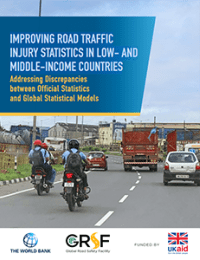
Road safety is a global health and economic issue that disproportionately affects low- and middle-income countries (LMICs). Precise data is crucial for understanding the full scope of the problem and developing effective interventions, but LMICs struggle to collect comprehensive data due to limited resources, underdeveloped health systems, and inconsistent data collection processes.
To overcome reporting gaps, three major global statistical models are utilized: The Institute for Health Metrics and Evaluation Global Burden of Disease (GBD) study, the World Health Organization (WHO) Global Status Reports on Road Safety (GSRRS), and WHO Global Health Estimates (GHE). However, discrepancies exist among these models and between them and official country statistics. They often estimate significantly higher road traffic fatalities and injuries than official LMIC statistics.
This GRSF study identifies the reasons behind statistical discrepancies and outlines strategies to strengthen modeling efforts. This involved qualitative research, a systematic review of national data availability, and four case studies in Brazil, Cambodia, Ethiopia, and Tanzania.
Key findings include:
Recommendations include:
To achieve the goal of the Second United Nations Decade of Action for Road Safety (reducing road traffic fatalities and injuries by 50% by 2030), substantial resources need to be allocated to road safety and accurate reporting and statistical estimates are required.
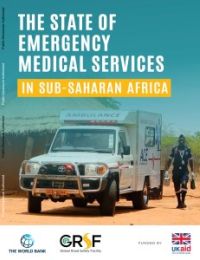
An evaluation of the various Emergency Medical Services (EMS) models and mechanisms in place in Sub-Saharan Africa (SSA) is critical in order to have a better understanding of what can be improved upon for effective pre-hospital and emergency care services (PECS). With grant funding provided by the World Bank’s Global Road Safety Facility (GRSF), this report aims explore the State of EMS Systems in Sub-Saharan Africa through a review of the models and mechanisms being developed across various States.
The premise of the report focuses on the fundamentals for effectively providing satisfactory treatment to those in need of urgent medical care, while also recognizing that there are multiple pathways, framed by the respective legislative, legal and regulatory enabling environments, towards a more formal and sustainable EMS model. It represents an effort to identify the major similarities and differences, as well as potential opportunities for greater coordination or collaboration, that can lead to the development of sound policy recommendations for fostering and expanding post-crash response services in the region.
High-level system information has been collected through questionnaires distributed to National Respondents in each country, for which 25 of 44 countries substantially responded as of April 2019 (collectively hereinafter referred to as SSA countries): Botswana, Burkina Faso, Burundi, Cabo Verde, Cameroon, Central African Republic, Chad, Comoros, Congo Brazzaville, Gabon, Lesotho, Liberia, Madagascar, Malawi, Mauritania, Niger, Rwanda, Senegal, Sierra Leone, Sudan, Tanzania, Togo, Uganda, Zambia and Zimbabwe. Missing data and discrepancies triggered a detailed review of laws and other regulatory acts, policy and plan.
The Report does not consider the advantages and disadvantages for the EMS models adopted by SSA countries, nor does it take a position on which regulatory approach should be applied, or measure the degree of EMS standards implementation and the success or failure of implementing various EMS policies. The principal aim of this report is to capture the current range of the standards and regulations in key areas of EMS systems across SSA.
The State of Emergency Medical Services in Sub-Saharan Africa is supported by UK Aid through the World Bank’s Global Road Safety Facility.
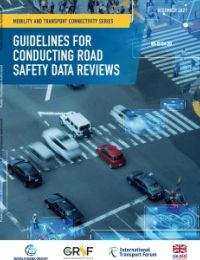
Download the document in English
Download the document in French
Download the document in Spanish
In many countries around the world, deficiencies in data or data quality impair evidence-based road safety policy making. While many countries collect road safety data, the collection is not necessarily comprehensive. Further, many countries can be unaware of data gaps in their system, which prevents them from soundly analyzing their road safety problems. Therefore, road safety data definitions and collection methods must converge into standard international criteria, thus allowing for comparisons in space - across countries - and in time.
This is the raison d’etre of regional road safety observatories, which have been developed, for example, in Latin America (OISEVI), Africa (ARSO), and Asia-Pacific (APRSO). They present an opportunity for joint regional efforts to improve, in a harmonized way, road safety data collection and analysis. Regional road safety observatories promote the adoption of a common set of road safety indicators based on common definitions and serve as an avenue to assist countries in improving the management of their crash data systems.
This document is designed to support reviewers in the assessment of road safety data collection; the complete range of safety data should be considered. This task can be complicated because collection of road safety data is often not achieved by activities dedicated to this purpose, but rather through piggybacks on other sources. For example, activity reports from police or hospitals are used to provide material for legal or medical purposes. The routines involved frequently have a long history in which gathering reliable and complete statistics has had secondary priority, at best. The various actors involved reflect the complex structure of a country’s judicial and executive system, which, generally, are not coordinated. Consequently, any review of the data collection process requires some “detective work.”
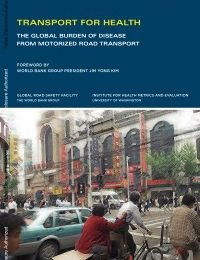
This report summarizes the findings of a long and meticulous journey of data gathering and analysis to quantify the health losses from road deaths and injuries worldwide, as part of the path-finding Global Burden of Disease (GBD) study. It is important, first, to acknowledge the profound contribution made by the lead authors and global team of injury prevention professionals to estimate the disease burden of road trauma, before absorbing their findings and recommendations. Without their dedication and tenacity, the way forward would be less certain.
The first GBD study, published nearly two decades ago, signaled an emerging road safety crisis in developing regions of the world. It triggered a remarkable program of global advocacy that culminated in the United Nations decade of action for road safety and a global plan to bring road safety outcomes under control in these regions by 2020. However, limited investment has been mobilized so far to implement the UN initiative. The second GBD studies, and related analyses presented in this report, confirm the importance of road safety as a global development priority and the urgency with which it must be addressed.
The report's findings highlight the growth in road deaths and injuries globally, and their substantial impacts on maternal and child health, despite sustained reductions over the last three to four decades in high-income countries. Combined with the deaths arising from vehicle pollution, the road transport death toll exceeds that of, for example, HIV/AIDS, tuberculosis, malaria, or diabetes. This statistic further reinforces the call for global action. Without these GBD estimates, we would not have a clear picture of the true situation because official country data in the developing world vastly understate the scale of road transport health losses.
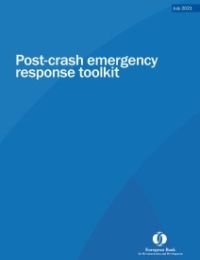
What is this toolkit?
This toolkit sets out the key elements of effective post-crash emergency response. The toolkit covers:
Who is this toolkit for?
The toolkit is for all stakeholders with an interest in post-crash response. This includes:
How to use it
The toolkit describes basic good practices for organizing an effective post-crash response. It is a starting point for dialogue and discussion, aimed at identifying goals for improving post-crash services. Every country has different structures and challenges, so the toolkit is not “one-size-fits-all.” However, certain elements of good post-crash response apply everywhere: the need for strategic planning and investment, good coordination, communication, equipment, and training.
To learn more about this project, click here.

Road safety is a major public health issue in Cambodia. Reducing the number of road crashes is a priority for the government. Accurate data are needed to design the most effective interventions. Improving the current crash data system will furnish a more comprehensive picture of critical road safety issues in Cambodia and provide the basis for developing policies to save more lives.
In the framework of the development of the Asia Pacific Road Safety Observatory (APRSO), the World Bank and the International Transport Forum (ITF), with the support of the Cambodian Government, initiated a project aimed at assessing the crash data system in Cambodia and developing a road map for strengthening this system.
This project follows up on a previous twinning project between Cambodia and the Netherlands, undertaken in the framework of the International Road Traffic and Accident Database (IRTAD) group of ITF in 2010-2014. That project concerned both a review of the Road Crash and Victim Information System (RCVIS), and training and support to develop a national road safety strategy and related indicators.
The current project started in 2019 and was carried out by the World Bank and the ITF, with support from the Global Road Safety Facility (GRSF) and UK AID. The Dutch Road Safety Research Institute, SWOV, was contracted by the ITF to lead the review.
This report provides conclusions and recommendations on the basis of the data review mission undertaken in December 2019.
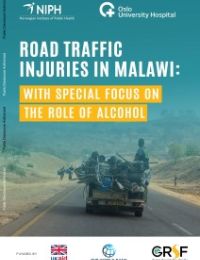
Road traffic crashes are one of the most important causes for physical and psychosocial disease burden and early death worldwide. The United Nations (UN) declared the Decade of Action for Road Safety during the period 2011-2020, with the objective to halve the number of road traffic deaths by 2020. While the number of fatal road traffic crashes has decreased since then in high-income countries (HIC), it has increased in low- and middle-income countries (LMIC). Worldwide, about 90% of the crashes are recorded in LMIC (2016), while these countries had only about 60% of the motor vehicles.
Driving under the influence of alcohol is one of the principal reasons for road traffic crashes. The use of alcohol is also a risk factor for other road users, such as pedestrians and bicyclists. The involvement of alcohol in injurious and fatal road traffic crashes has been well documented in most HICs, but data for LMICs is scarce, particularly for African countries.
The study is a collaborative effort among the Kamuzu Central Hospital (KCH), the Norwegian Institute of Public Health (NIPH) and the Oslo University Hospital (OUH), with the financial support of UK Aid through the Global Road Safety Facility (GRSF), the International Council on Alcohol Drugs and Traffic Safety (ICADTS) and the Norwegian Council for Road Safety (Trygg Trafikk).
The objective of the study was to generate new knowledge about road traffic injuries in Malawi and the extent of traffic accidents related to alcohol use, to increase capacity to conduct alcohol-testing, and develop a database for the findings, which in turn will form the basis for future policymaking to reduce traffic accidents.
The objectives were achieved through collecting data on patients who sought treatment after road traffic crashes and admitted to the Emergency Department at Kamuzu Central Hospital in Lilongwe, Malawi. The data included basic information about the patients, alcohol use before the injury, and information about accident circumstances, including types of road users and vehicles involved. Knowledge and training of local KCH employees to perform alcohol testing and record data were an important aspect of this study.
RESULTS ⌵︎
Acknowledgments ⌵︎
This research project was made possible with the financial support of UK Aid through the Global Road Safety Facility, the International Council on Alcohol Drugs and Traffic Safety and the Norwegian Council for Road Safety.

